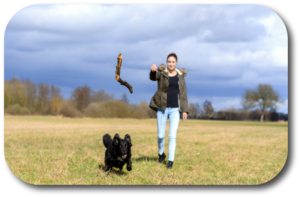Most people think that all dogs love to play fetch. They throw the ball or a Frisbee for their dog and he just looks at them. They yell “Fetch! Fetch!” and their dog just lays at their feet. Is their dog dumb? We had a new Home Dog Training Client in Cumming ask this question during our training session last week.

We answered “No, your dog is not dumb”. Like most things, our client misunderstood that “Fetch” is a learned behavior just like Sit, Stay, Come, etc. He also needed to understand that some dogs just might not like to play “Fetch”.
For the moment, let’s assume that his dog would like to play fetch. Just because he would like to play the game of “Fetch” doesn’t mean that he knows how. Our client needs to teach him “how to Fetch”.
We always like to tell our clients that there are three actions to “Fetch”. The first action requires their dog to run and pick up the object that they threw. The second action is when their dog brings the “fetch toy” to them. The third action is when their dog drops the toy. Teaching their dog to fetch successfully and quickly requires that they work on each of these actions.
Get the Object:
The first thing we asked our client was to put a collar and long lead on his dog. We won’t be using the long lead for this part of the exercise, but it will become critical in the second part of our training.
We asked our client to find a toy that really excites his dog. We then tell him to grab and actively wave it in the air around him and his dog. He should say things such as “Where’s the toy? Get it, Get it Get it!!! Oh boy! Oh Boy! Fetch! Fetch!” in a very excited, animated way while continuing to wave the toy.
Throw it just a few feet away and see if his dog goes after it. If his dog does not go over to the toy, he should go over to the toy in a very animated manner, stoop or lean over the toy, and point to it. He should then say things like “Get the toy! Where’s the toy!” in an excited manner.
If his dog still doesn’t come over and get the toy, he needs to elevate the excitement. He now needs to get down on the ground, pick it up and play with it until his dog comes over. We then want him to shake it in front of his dog’s face until his dog grabs it. As soon as his dog grabs the toy, let go and say “Good boy”.
If his dog still needs come coaxing, we suggest changing from a toy to a dog goodie or chew bone. As soon as his dog is constantly going after that, he should replace it with a toy that he has coated with a slight “goodie smell”. (Rub a little gravy or raw meat on the toy.) As he continues to practice the activity, he can slowly decrease the amount of the “goodie smell” on the toy.
Once his dog is going after the toy, increase the distance until his dog is going across the room or yard to get the toy. His dog has now completed the “get the object” action. Ready to move on…
Bring it Back:
Having his dog bring the object back to him is the “Come” command with something in his dog’s mouth. This is where the training lead may be needed.
So, first he throws the toy and his dog goes and gets it on the other side of the yard.
Now, say a command like “Fetch”. If his dog doesn’t come back to him, he needs to stoop down and tug the training lead to direct his dog in his direction. If his dog still doesn’t come, he needs to tug the training lead in his direction again.
If his dog still doesn’t return to him (some dogs are a little suborn), he should decrease the distance he is throwing the toy.
Our client now needs to repeat the action until his dog will return the toy without his having to tug on the lead for direction.
Drop It:
Our client now can get his dog to get the object he threw and bring it back to him. The last thing his dog needs to perform is to present it to our client. In other words, the dog needs to “Drop It”.
We ask our client to tell his dog “Drop It’. If the dog doesn’t let go, our client can correct his dog with a quick tug on the leash. This will momentarily redirect his dog and cause him to drop the toy. He should now praise his dog for obeying him and doing a great job.
Our client has not taught his dog to “Fetch”.
Please call Robin or me at (770) 718-7704 if you need any dog training help. We are blessed to have been your local dog training professionals for over fifteen years. We have trained over 5,000 great dogs and loving families and are ready to help you.

Follow Us!